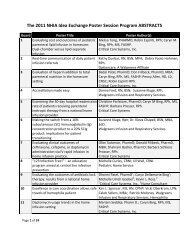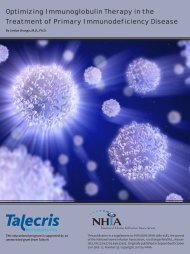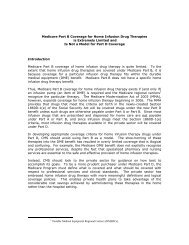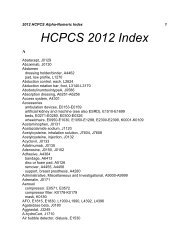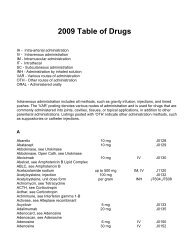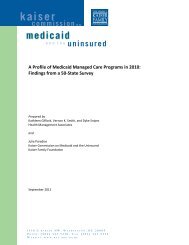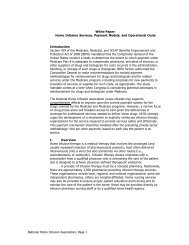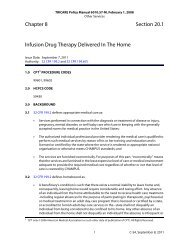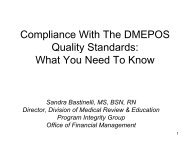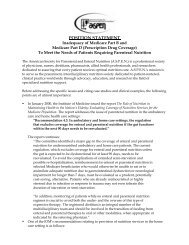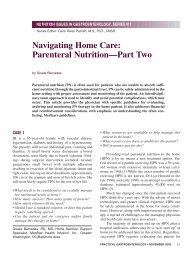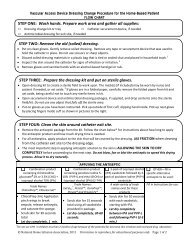Helping to Place the Pieces Together Through Leadership ... - NHIA
Helping to Place the Pieces Together Through Leadership ... - NHIA
Helping to Place the Pieces Together Through Leadership ... - NHIA
You also want an ePaper? Increase the reach of your titles
YUMPU automatically turns print PDFs into web optimized ePapers that Google loves.
<strong>Helping</strong> <strong>to</strong> <strong>Place</strong> <strong>the</strong> <strong>Pieces</strong> Toge<strong>the</strong>r<br />
<strong>Through</strong> <strong>Leadership</strong>, Policy, and Financial Support<br />
The <strong>NHIA</strong> Future of Infusion Advisory Council (FIAC) brings <strong>to</strong>ge<strong>the</strong>r outstanding manufacturing and<br />
service companies who have pledged leadership, policy, and financial support <strong>to</strong> <strong>the</strong> National Home Infusion<br />
Association (<strong>NHIA</strong>). The Council works closely with <strong>the</strong> <strong>NHIA</strong> Board, leadership staff, and provider<br />
members <strong>to</strong> address <strong>the</strong> most critical issues, opportunities and challenges facing <strong>the</strong> home and specialty<br />
infusion industry—and this publication provides informative organizational profiles for each of <strong>the</strong> 10<br />
2012 – 2013 FIAC member companies.
In Appreciation<br />
On behalf of <strong>the</strong> <strong>NHIA</strong> membership, we would like <strong>to</strong> extend our deepest appreciation <strong>to</strong> <strong>the</strong> members<br />
of <strong>the</strong> association’s Future of Infusion Advisory Council (FIAC) for supporting our mission <strong>to</strong> be <strong>the</strong> trade<br />
association that truly represents <strong>the</strong> home and specialty infusion community. The FIAC brings <strong>to</strong>ge<strong>the</strong>r<br />
outstanding manufacturing and service companies who have pledged leadership, policy, and financial<br />
support <strong>to</strong> <strong>NHIA</strong>—and <strong>to</strong> advance our industry.<br />
As part of <strong>NHIA</strong>’s efforts <strong>to</strong> broaden its connection <strong>to</strong> include all key stakeholders—providers, as well<br />
as supporting businesses—we invited <strong>the</strong>se companies <strong>to</strong> join in a unique partnership that has streng<strong>the</strong>ned<br />
<strong>the</strong> association immensely. FIAC companies join with <strong>NHIA</strong>’s providerbased Board of Direc<strong>to</strong>rs <strong>to</strong><br />
address <strong>the</strong> most critical issues, opportunities and challenges facing <strong>the</strong> industry. In a formal process<br />
that was launched in 2008, <strong>the</strong> FIAC engages regularly with <strong>the</strong> Board in a strategic planning process<br />
that sets <strong>NHIA</strong>’s course for successfully navigating <strong>the</strong> future.<br />
The myriad results have been gratifying on a number of levels. Not only have we improved <strong>the</strong> field for<br />
home infusion providers and supporting businesses alike, we have created a forum for dialogue that<br />
has increased understanding on both sides. We believe that this new depth of cooperation has improved<br />
<strong>the</strong> innovation of product and service offerings <strong>to</strong> meet <strong>the</strong> dynamic needs of providers in <strong>the</strong> field, as<br />
well as building a trust and appreciation for partners in <strong>the</strong> marketplace.<br />
The financial support and guidance provided by <strong>the</strong> FIAC have streng<strong>the</strong>n <strong>the</strong> association and allowed<br />
us <strong>to</strong> address some critical longstanding needs, such as <strong>the</strong> <strong>NHIA</strong> IndustryWide Data Initiative and a<br />
comprehensive study of home infusion service and reimbursement—foundational elements in <strong>the</strong> drive<br />
for a meaningful Medicare benefit. There is no question that with <strong>the</strong> help of <strong>the</strong> FIAC members, <strong>NHIA</strong><br />
and <strong>the</strong> entire alternatesite field is better positioned <strong>to</strong> succeed in <strong>the</strong> dynamically changing future of<br />
health care delivery.<br />
By stepping forward, <strong>the</strong> 10 FIAC members featured in this publication have demonstrated <strong>the</strong>ir<br />
commitment and leadership <strong>to</strong> <strong>the</strong> field—and, <strong>the</strong>reby, fortifying our collective future. We invite you<br />
<strong>to</strong> learn more about <strong>the</strong>ir involvement with <strong>NHIA</strong>, and support <strong>the</strong>m whenever you can.<br />
Mary Cope, R.Ph.<br />
Chair <strong>NHIA</strong> Board of Direc<strong>to</strong>rs<br />
Russell Bodoff<br />
<strong>NHIA</strong> President & CEO
Table of Contents<br />
FIAC Profile*..........................................Page Number<br />
Baxter Healthcare Corporation........................................2<br />
B.Braun Medical, Inc. ........................................................4<br />
Cubist Pharmaceuticals, Inc. ............................................6<br />
Hospira Worldwide, Inc....................................................8<br />
Innovatix, LLC ..................................................................10<br />
Managed Health Care Associates, Inc. ...........................12<br />
Medical Specialties Distribu<strong>to</strong>rs, LLC ............................14<br />
Moog Medical Devices ....................................................16<br />
Octapharma USA .............................................................18<br />
Smiths Medical................................................................20<br />
*Note: <strong>NHIA</strong> had final edi<strong>to</strong>rial control over all material in this publication.<br />
1
FIAC Profile<br />
Baxter Healthcare Corporation<br />
Much like <strong>the</strong> alternatesite infusion field, Baxter International<br />
Inc., is built on a long his<strong>to</strong>ry of innovation. As a pioneer<br />
in <strong>the</strong> commercial manufacture of intravenous<br />
solutions, <strong>the</strong> company with more than 50,000 employees worldwide<br />
has advanced lifesaving products and <strong>the</strong>rapies for more<br />
than 80 years.<br />
While <strong>the</strong> company has global reach, it understands <strong>the</strong> distinctive<br />
needs of its cus<strong>to</strong>mers in home infusion and specialty pharmacy<br />
because it interacts so closely with <strong>the</strong>m. “We recognize that<br />
<strong>the</strong> home care business model is different than an acute care setting,” explains Ivan Forehand, Direc<strong>to</strong>r, National Accounts,<br />
Alternate Site, for Baxter’s U.S. Medication Delivery business. Forehand notes that <strong>the</strong> company’s contracting, inven<strong>to</strong>ry,<br />
and o<strong>the</strong>r business functions ensure that home infusion accounts receive <strong>the</strong> same level of support.<br />
“Our dedicated alternate care sales team offers a single point of contact <strong>to</strong> work with our home infusion cus<strong>to</strong>mers<br />
<strong>to</strong> provide expertise as needed,” he continues. “They understand <strong>the</strong> needs of <strong>the</strong> pharmacy and <strong>the</strong> home care patient,<br />
which allows for robust problem solving.” The Baxter team’s expertise can range from training on products <strong>to</strong><br />
providing clinical resources and services. “As part of our Clinical Center of Excellence, we offer pharmacist<strong>to</strong>pharmacist<br />
consultations and product specialists who can provide a higher level of consultative interaction for specific<br />
pharmacy products,” he explains.<br />
Meeting <strong>the</strong> Needs of <strong>the</strong> Market<br />
Having a long his<strong>to</strong>ry of servicing <strong>the</strong> home infusion market has allowed Baxter <strong>to</strong> develop several products designed with<br />
ease of use and safety in mind. “Our focus comes from being a major supplier of sterile products going in<strong>to</strong> patient’s homes,<br />
hospitals, clinics, and physician’s offices,” observes Dennis Schneider, Vice President of Marketing for U.S. Medication Delivery<br />
– Pharmacy Operations, Baxter Healthcare Corporation. In addition <strong>to</strong> bringing new products <strong>to</strong> market, Baxter has<br />
a track record of innovating through expansion and improvement.<br />
“The Baxter product portfolio has been refined <strong>to</strong> meet <strong>the</strong> cus<strong>to</strong>mer’s needs with emphasis on <strong>the</strong> areas of nutrition<br />
and drug delivery,” adds Forehand.<br />
The SIGMA Spectrum Infusion System is a good example, according <strong>to</strong> Schneider. “With second generation smart technology,<br />
it’s easy <strong>to</strong> program and offers several enhanced safety features.” Drug libraries and dose error reduction software<br />
protect patients and programmers from errors, he says. “It’s a precise, modern system that works in <strong>the</strong> home setting.”<br />
Ano<strong>the</strong>r product line that improves care for homebased patients is shelfstable CLINIMIX sulfite free (Amino Acids in<br />
Dextrose) Injections, parenteral nutrition product. “For patients who can take advantage of <strong>the</strong>se premix solutions, CLIN<br />
IMIX is a convenient option,” says Schneider. “It simplifies <strong>the</strong> process since refrigeration isn’t an issue. The added flexibility<br />
can afford a lifestyle change, which for patients depending on parenteral nutrition every day is significant.”<br />
Baxter’s expertise in nutrition support—and safer IV dose preparation—was greatly<br />
enhanced in 2011 when <strong>the</strong> company purchased Baxa Corporation, makers of advanced<br />
au<strong>to</strong>mated compounding systems. “Both <strong>the</strong> Institute for Safe Medication Practices<br />
and <strong>the</strong> Joint Commission recommend using au<strong>to</strong>mated compounding systems when<br />
making cus<strong>to</strong>m complex intravenous <strong>the</strong>rapies such as parenteral nutrition,” Schneider<br />
notes. “Acquiring Baxa streng<strong>the</strong>ns Baxter’s commitment <strong>to</strong> nutrition as well as<br />
patient safety and allows us <strong>to</strong> offer more solutions for <strong>the</strong> safe preparation and delivery<br />
of IV medications.”<br />
2
Because it has a major presence<br />
in <strong>the</strong> acute care market<br />
as well, Baxter is well prepared<br />
<strong>to</strong> assist in patient care across<br />
<strong>the</strong> continuum. “We work effectively<br />
across <strong>the</strong> spectrum<br />
of health care<br />
settings,” observes Schneider,<br />
“and see a clear trend<br />
<strong>to</strong> moving more care <strong>to</strong> <strong>the</strong><br />
outpatient and home care<br />
settings.”<br />
“We help hospital pharmacies transition and manage patients<br />
as <strong>the</strong>y’re discharged <strong>to</strong> <strong>the</strong> alternatesite or home,”<br />
adds Forehand, noting that many of <strong>the</strong> company’s product<br />
offerings are designed <strong>to</strong> help manage patients needing<br />
continued medication and tracking <strong>to</strong> ensure compliance.<br />
He cites <strong>the</strong> INTERMATE and MINIBAG PLUS container<br />
system as examples. “These are two userfriendly products<br />
that allow patients <strong>to</strong> easily administer antibiotics while providing<br />
<strong>the</strong> pharmacy a safe and costeffective delivery<br />
method <strong>to</strong> support home <strong>the</strong>rapy,” he explains. “We also<br />
have created patient guides that our home infusion cus<strong>to</strong>mers<br />
can provide <strong>to</strong> <strong>the</strong>ir patients on proper use of certain<br />
products.”<br />
Active <strong>Leadership</strong><br />
In addition <strong>to</strong> providing leadership in times of immediate<br />
need, Baxter is involved in shaping <strong>the</strong> future of <strong>the</strong> industry.<br />
“We understand that providers are evolving in response<br />
<strong>to</strong> <strong>the</strong> changing health care landscape and <strong>the</strong><br />
movement of care in<strong>to</strong> <strong>the</strong> home,” says Forehand.<br />
“They’re seeking <strong>to</strong> move <strong>to</strong> integrated care models that<br />
span <strong>the</strong> entire value chain, including care in<strong>to</strong> <strong>the</strong> home<br />
and o<strong>the</strong>r alternate sites.”<br />
Baxter is responding <strong>to</strong> <strong>the</strong>se needs by innovating differentiated<br />
products and by focusing on services across <strong>the</strong><br />
continuum. But <strong>the</strong> company also sees <strong>the</strong> benefit of collaborating<br />
with <strong>the</strong> alternatesite infusion field as changes<br />
take place. “We greatly value <strong>the</strong> collaboration we have had<br />
with <strong>NHIA</strong> as <strong>the</strong> leading association in <strong>the</strong> home infusion<br />
industry,” he says.<br />
Baxter has been an active participant on <strong>NHIA</strong>’s Future of<br />
Infusion Advisory Council (FIAC), remaining closely involved<br />
in <strong>the</strong> organization and setting a direction for <strong>the</strong> industry.<br />
“<strong>NHIA</strong> and Baxter share a common commitment of meeting<br />
<strong>the</strong> needs of <strong>the</strong> growing home patient population,” concludes<br />
Forehand.<br />
Responding <strong>to</strong> <strong>the</strong> Need for Change<br />
While <strong>the</strong> backdrop continues <strong>to</strong> shift, <strong>the</strong> past several years<br />
have brought additional pressures <strong>to</strong> bear on health care delivery.<br />
Drug shortages and compounding practices are now<br />
“landscape items,” according <strong>to</strong> Schneider. “One thing Baxter<br />
does well is respond <strong>to</strong> <strong>the</strong> need for change,” he asserts,<br />
explaining that <strong>the</strong> company has been on <strong>the</strong> forefront of addressing<br />
<strong>the</strong>se clinical and operational challenges.<br />
“When Baxter acquired Baxa, we became even more active<br />
in educating pharmacists on safe practices—and how<br />
<strong>to</strong> examine <strong>the</strong>mselves and <strong>the</strong>ir facilities with a renewed<br />
perspective on patient safety,” continues Schneider. “This<br />
message is underscored at our Star Center training facility,<br />
which offers handson training for leadership in best practice<br />
sterile compounding in a stateof<strong>the</strong>art facility.”<br />
For more information on this valued FIAC member,<br />
please visit: www.baxter.com<br />
3
FIAC Profile<br />
B.Braun Medical, Inc.<br />
Health care delivery is increasingly taking place outside <strong>the</strong><br />
hospital walls. This trend is apparent <strong>to</strong> Bethlehem, Pennsylvaniabased<br />
B. Braun Medical Inc. (B.Braun), a global<br />
company specializing in infusion <strong>the</strong>rapy and pain management.<br />
“In <strong>the</strong> U.S., and globally, <strong>the</strong> outpatient market is a focus for<br />
B.Braun,” says Don Nymberg, Vice President of <strong>the</strong> company’s<br />
OPM (Outpatient Markets) Division. “We are committed <strong>to</strong> providing<br />
<strong>the</strong> highestquality products and services <strong>to</strong> our cus<strong>to</strong>mers in<br />
this marketplace,” he adds, noting that this is <strong>the</strong> primary vehicle<br />
for bringing value <strong>to</strong> providers in <strong>the</strong> home infusion <strong>the</strong>rapy and specialty infusion field.<br />
Sharing Expertise<br />
According <strong>to</strong> Nymberg, B.Braun has helped shape <strong>the</strong> home infusion <strong>the</strong>rapy market for decades by using expertise and<br />
experience gained in both inpatient acute care and outpatient settings <strong>to</strong> create a line of innovative, safe, highquality,<br />
easy<strong>to</strong>use products and services specifically designed for <strong>the</strong> home and alternatesite use.<br />
“We have a very diversified product portfolio that can be used in different settings and we<br />
can tailor our products <strong>to</strong> meet <strong>the</strong> needs of our cus<strong>to</strong>mers in <strong>the</strong> home infusion and alternatesite<br />
setting,” he observes.<br />
“B.Braun also has a team of sales representatives and national account representatives<br />
dedicated <strong>to</strong> <strong>the</strong> home infusion market, who consult with our cus<strong>to</strong>mers on<br />
a routine basis,” Nymberg continues, noting that <strong>the</strong> company prides itself on understanding<br />
<strong>the</strong> challenges and opportunities facing its cus<strong>to</strong>mers.<br />
“Appreciating <strong>the</strong> needs of cus<strong>to</strong>mers builds relationships and adds value,” says<br />
Nymberg. A prime example of B.Braun’s focus on adding value is its au<strong>to</strong>mated compounder,<br />
Pinnacle ® , which has gained a much larger footprint over <strong>the</strong> years in <strong>the</strong> outpatient<br />
setting. “The system includes Trissel’s Ca/P graphical compatibility curves, which<br />
were developed in collaboration with national drug compatibility expert, Lawrence Trissel, R.Ph., <strong>to</strong> address calcium/phosphate<br />
compatibility in an effort <strong>to</strong> reduce potential errors,” explains Nymberg. “Clinicians have checks and balances throughout<br />
<strong>the</strong> entire <strong>to</strong>tal parenteral nutrition (TPN) process resulting in a high level of efficiency, accuracy, and safety,” he adds.<br />
B.Braun understands <strong>the</strong> level of expertise required <strong>to</strong> deliver clinical excellence, adds Nymberg, and <strong>the</strong> company is<br />
dedicated <strong>to</strong> supporting that expertise in a variety of ways. “Our dedicated teams follow <strong>the</strong> business markets and have a<br />
high acuity on how patients interact in <strong>the</strong> home setting,” he explains.<br />
“B.Braun also has a home infusion website (www.hit.bbraunusa.com), which provides its cus<strong>to</strong>mers with an overview<br />
of our product offerings, services, and industry resources—all of which underscores our Sharing Expertise ® philosophy.”<br />
The website, designed as a nexus of knowledge, offers quick access <strong>to</strong> information about specific industry issues or indepth<br />
educational materials on essential <strong>to</strong>pics like compliance with USP .<br />
On <strong>the</strong> Horizon<br />
“The alternatesite infusion field faces a number of significant issues,” continues Nymberg. He cites clinical issues such as<br />
drug shortages and safe compounding practices, as well as overall health care trends, such as shrinking reimbursement<br />
4
and <strong>the</strong> need <strong>to</strong> control spiraling health costs through delivery<br />
system reform. “Our cus<strong>to</strong>mers in <strong>the</strong> alternatesite<br />
field are constantly trying <strong>to</strong> figure out what <strong>the</strong> ultimate<br />
impact will be. We can share our expertise with <strong>the</strong> infusion<br />
industry by incorporating our knowledge and experience in<br />
all markets in<strong>to</strong> <strong>the</strong> conversation,” he offers.<br />
In addition <strong>to</strong> bringing a broader perspective <strong>to</strong> <strong>the</strong><br />
table, B.Braun offers solutions that can help providers reduce<br />
costs and improve <strong>the</strong>ir practice—two of <strong>the</strong> most<br />
pressing needs in health care <strong>to</strong>day. “B.Braun is committed<br />
<strong>to</strong> IV <strong>the</strong>rapy and continues <strong>to</strong> invest in <strong>the</strong> development<br />
of products and services <strong>to</strong> support that<br />
commitment,” asserts Nymberg.<br />
“One of <strong>the</strong> trends that remains a strong challenge for<br />
<strong>the</strong> entire health care industry is <strong>the</strong> difficulty in finding<br />
enough skilled workers <strong>to</strong> treat an influx of patients created<br />
by <strong>the</strong> aging population,” he observes, noting that this is<br />
especially concerning in home care because <strong>the</strong> setting is<br />
widely recognized as a lowercost alternative and <strong>the</strong> preference<br />
of most patients. “Modifying our education and<br />
training services <strong>to</strong> make it easier and faster for clinicians <strong>to</strong><br />
complete <strong>the</strong>ir training has become a major focal point at<br />
B.Braun,” he continues.<br />
Realizing that providers face challenges finding, training,<br />
and retaining qualified nurses and pharmacists—and have<br />
<strong>to</strong> accomplish more with a smaller staff—B.Braun boxed up<br />
its education and training services <strong>to</strong> make <strong>the</strong>m easier and<br />
quicker <strong>to</strong> use. Cus<strong>to</strong>mers can now access information on<br />
devices, essential industry issues, and even clinical continuing<br />
education electronically. “Providing education and training<br />
solutions gives us an opportunity <strong>to</strong> help our<br />
cus<strong>to</strong>mers in <strong>the</strong> home infusion industry meet<br />
growing business demands,” says Nymberg.<br />
Reimbursement pressures also challenge<br />
effective delivery of services in<br />
<strong>the</strong> home. Medicare reimbursement<br />
for home infusion <strong>the</strong>rapy is<br />
something that <strong>the</strong> FIAC has<br />
worked on over <strong>the</strong> years.<br />
Seat at <strong>the</strong> Table<br />
An important component of B.Braun’s outpatient market<br />
focus is <strong>the</strong> company’s longtime participation in and support<br />
of <strong>NHIA</strong> and its programs, including <strong>the</strong> Future of Infusion<br />
Advisory Council (FIAC). “B.Braun values its partnership<br />
with <strong>NHIA</strong>, says Nymberg. “We are proud <strong>to</strong> be one of <strong>the</strong><br />
industry leaders participating in <strong>the</strong> FIAC.”<br />
Contributing at <strong>the</strong> leadership level is important <strong>to</strong> <strong>the</strong><br />
company, because it provides a window <strong>to</strong> <strong>the</strong> issues facing<br />
<strong>the</strong> field as well as an opportunity <strong>to</strong> share B.Braun’s own<br />
perspective—<strong>the</strong> result of years serving <strong>the</strong> entire health<br />
care spectrum. “Taking part in <strong>the</strong> FIAC’s meetings, where<br />
broad issues are explored in <strong>the</strong> context of industry strategy<br />
and direction, is critical,” observes Nymberg. “It gives us a<br />
voice and builds relationships.”<br />
B.Braun has cultivated a longstanding dialogue with<br />
cus<strong>to</strong>mers and key industry leaders and stakeholders,<br />
says Nymberg, and engaging with <strong>NHIA</strong> at <strong>the</strong> leadership<br />
level only enhances those efforts. “These interactions<br />
with providers and o<strong>the</strong>r manufacturers and service<br />
providers increases our understanding of <strong>the</strong> market and<br />
deepens <strong>the</strong> exchange of ideas that’s so essential <strong>to</strong> success,”<br />
he observes.<br />
“Our cus<strong>to</strong>mers know we are engaged and that we understand<br />
<strong>the</strong>ir business at <strong>the</strong> granular level,” Nymberg continues.<br />
“The challenges of health care often transcend areas<br />
of care, so we feel it’s important <strong>to</strong> take our experiences in<br />
all markets and use it <strong>to</strong> provide knowledge and value <strong>to</strong><br />
our cus<strong>to</strong>mers.”<br />
Trissel’s is a trademark of Lawrence A. Trissel, R.Ph.<br />
For more information on this valued FIAC member,<br />
please visit: www.bbraunusa.com<br />
5
FIAC Profile<br />
Cubist Pharmaceuticals, Inc.<br />
Cubist Pharmaceuticals describes itself as a biopharmaceutical company focused<br />
on <strong>the</strong> research, development, and commercialization, of pharmaceutical<br />
products that address unmet medical needs in <strong>the</strong> acute care environment.<br />
And while <strong>the</strong> company’s focus on development of novel <strong>the</strong>rapies is designed <strong>to</strong><br />
benefit patients in hospitals and o<strong>the</strong>r acute care environments, <strong>the</strong>y are no strangers<br />
<strong>to</strong> <strong>the</strong> alternatesite infusion field.<br />
Headquartered in Lexing<strong>to</strong>n, Massachusetts, Cubist is best known in <strong>the</strong> outpatient<br />
setting for marketing CUBICIN ® (dap<strong>to</strong>mycin for injection). The company’s clinical<br />
product pipeline currently consists of a Phase 3 program focused on <strong>the</strong> development<br />
of a novel cephalosporin <strong>to</strong> address certain serious infections caused by multidrug<br />
resistant (MDR) gramnegative organisms, a Phase 3 program for <strong>the</strong> treatment of<br />
Clostridium difficileassociated diarrhea (CDAD), and a Phase 3 program for <strong>the</strong> treatment<br />
of chronic opioidinduced constipation (OIC). Cubist also is working on several preclinical programs <strong>to</strong> address areas<br />
of significant medical needs, including <strong>the</strong>rapies <strong>to</strong> treat serious bacterial infections and acute pain.<br />
So Much <strong>to</strong> GAIN<br />
With a research pipeline so focused on fighting infection, Cubist has been closely involved in addressing <strong>the</strong> public health<br />
threat caused by a growing array of MDR bacteria. This group, called “gramnegative” bacteria, is particularly dangerous<br />
because <strong>the</strong>y are very quick <strong>to</strong> develop resistance <strong>to</strong> current treatments. According <strong>to</strong> Centers for Disease Control and Prevention<br />
(CDC) data, more than 1.7 million people acquire bacterial infections in U.S. hospitals each year—and 99,000 people<br />
die as a result of <strong>the</strong>se bacterial infections, of which up <strong>to</strong> 70% are resistant <strong>to</strong> at least one drug.<br />
Health care providers are facing a dwindling supply of medical weapons <strong>to</strong> fight <strong>the</strong>se deadly foes. And, while efforts are<br />
underway <strong>to</strong> promulgate best practices that incorporate proper stewardship of existing antimicrobial <strong>the</strong>rapies, developing<br />
new <strong>to</strong>ols <strong>to</strong> replenish <strong>the</strong> dangerously low inven<strong>to</strong>ry is critical <strong>to</strong> successfully ensuring public health.<br />
However, developing new <strong>the</strong>rapies is not without its challenges. It takes researchers an average of 10 years <strong>to</strong> bring a<br />
single product <strong>to</strong> market, and <strong>the</strong> financial incentives are low given that antibiotics are prescribed for such short periods<br />
compared <strong>to</strong> drugs that treat chronic conditions.<br />
To address <strong>the</strong> growing health threat, Congress passed <strong>the</strong> Generating Antibiotics Incentives Now (GAIN Act), which was<br />
signed in<strong>to</strong> law in 2012 as part of <strong>the</strong> Food and Drug Administration Safety and Innovation Act. Cubist was closely involved<br />
in <strong>the</strong> development and passage of <strong>the</strong> GAIN Act, which incentivizes research and development and streamlines <strong>the</strong> FDA<br />
regula<strong>to</strong>ry review process. Passage of this legislation represents a significant achievement not only for Cubist, but for health<br />
care providers and patients across <strong>the</strong> continuum.<br />
“Without <strong>the</strong> GAIN Act, it would be significantly more difficult <strong>to</strong> develop new antimicrobial<br />
products for home infusion providers <strong>to</strong> utilize,” observes Mark T. Battaglini,<br />
Esq., Vice President of Government Affairs at Cubist. With antibiotics representing a<br />
significant percentage of home infusion <strong>the</strong>rapies, providers and patients alike rely<br />
on a robust pipeline of drug agents, he points out.<br />
Bringing it Home<br />
Cubist understands <strong>the</strong> critical role home infusion plays in quelling <strong>the</strong> spread of infection<br />
and battling resistance, according <strong>to</strong> Battaglini. “It’s one of <strong>the</strong> most costeffective set<br />
6
tings of care, not <strong>to</strong> mention <strong>the</strong>re are high rates of patient<br />
satisfaction and quality of life standards along with a reduced<br />
risk of nosocomial infections when you treat a patient<br />
outside <strong>the</strong> hospital,” he says. “We understand that<br />
so many of <strong>the</strong> health care reform changes coming through<br />
are based on moving patients from <strong>the</strong> acute care <strong>to</strong> outpatient<br />
setting.”<br />
“Yet, in many parts of <strong>the</strong> country, because of a lack of<br />
Medicare coverage, patients are sitting in clinics or spending<br />
time in acute care or skilled nursing facilities when <strong>the</strong>y<br />
could be getting treatment at home,” continues Battaglini.<br />
This is one example of common ground between Cubist and<br />
<strong>NHIA</strong> members, he points out. Ano<strong>the</strong>r is showing value.<br />
Home Infusion provides a good opportunity, explains<br />
Battaglini. “It can help reduce length of stay by providing<br />
quality care in <strong>the</strong> home —that’s meaningful.” At <strong>the</strong> same<br />
time, he adds, that value can only be realized through <strong>the</strong><br />
hands of skilled professionals and a cadre of related products<br />
and services required <strong>to</strong> safely and effectively administer<br />
<strong>the</strong> <strong>the</strong>rapy.<br />
Payers, including <strong>the</strong> Centers for Medicare & Medicaid<br />
Services (CMS) could better understand <strong>the</strong> impact of <strong>the</strong>ir<br />
decisions by considering value in <strong>the</strong> context of <strong>the</strong> bigger<br />
picture. Battaglini points <strong>to</strong> <strong>the</strong> Medicare Competitive Bidding<br />
Program as an example. “Getting <strong>the</strong> lowest price on<br />
a pump does not necessarily save money when you look <strong>the</strong><br />
entire cost <strong>the</strong>rapy,” he explains. “They’re not looking at<br />
<strong>the</strong> whole puzzle, just a few pieces.”<br />
On <strong>the</strong> commercial side, a deeper understanding of <strong>the</strong><br />
value of home infusion might prompt payers <strong>to</strong> hold down<br />
rising patient copays and deductibles <strong>to</strong> encourage utilization<br />
of overall costeffective settings. “If a patient chooses<br />
inpatient care because <strong>the</strong> daily copay at home is <strong>to</strong>o high,<br />
<strong>the</strong> larger savings are missed,” he explains.<br />
We need <strong>to</strong> demonstrate value by collecting and sharing<br />
data, observes Battaglini. “We have <strong>to</strong> be able <strong>to</strong> show savings<br />
from across <strong>the</strong> spectrum in areas such as reduced<br />
readmissions and hospital avoidance.”<br />
<strong>the</strong> same end users as your members, <strong>the</strong> patient who is ill,”<br />
he acknowledges, “but <strong>the</strong>re are also opportunities for us<br />
<strong>to</strong> educate one ano<strong>the</strong>r.”<br />
Education is especially important as health care reform<br />
changes are made and <strong>the</strong> overall health care environment<br />
changes, according <strong>to</strong> Battaglini. “You can come willingly or<br />
you can kick and scream, but change is coming and understanding<br />
it is <strong>the</strong> key <strong>to</strong> success.”<br />
Partners in Change<br />
Data collection and payer education are important pillars of<br />
<strong>NHIA</strong>’s strategic plan, which was developed with <strong>the</strong> input<br />
of <strong>the</strong> association’s Board of Direc<strong>to</strong>rs and Future of Infusion<br />
Advisory Council (FIAC). This type of common ground<br />
drew Cubist <strong>to</strong> participate in <strong>the</strong> FIAC, says Battaglini.<br />
“Working with <strong>NHIA</strong> is a priority because we are focused on<br />
For more information on this valued FIAC member,<br />
please visit: www.cubist.com<br />
7
FIAC Profile<br />
Hospira Worldwide, Inc.<br />
As infusion providers continue <strong>to</strong> seek out new ways <strong>to</strong> work across <strong>the</strong><br />
changing health care continuum, it’s important <strong>to</strong> partner with supporting<br />
businesses that have a bigpicture view and <strong>the</strong> ability <strong>to</strong> leverage<br />
<strong>the</strong>ir expertise and resources. Headquartered in Lake Forest, Illinois, Hospira,<br />
Inc., does just that by developing, manufacturing, and marketing products created<br />
<strong>to</strong> help improve <strong>the</strong> productivity, safety, and efficacy of patient care in all<br />
settings. The company offers a broad line of generic specialty injectables, and<br />
integrated solutions for medication management and infusion <strong>the</strong>rapy. In its<br />
nonacute business, Hospira has a long his<strong>to</strong>ry of commitment <strong>to</strong> supporting<br />
<strong>the</strong> home and alternatesite infusion <strong>the</strong>rapy field.<br />
Aligning with Alternate-Site Infusion<br />
“We strive <strong>to</strong> understand our cus<strong>to</strong>mers and <strong>the</strong>ir needs,” explains Paul Catenaro, Direc<strong>to</strong>r of National Accounts Sales<br />
and Marketing for Hospira’s nonacute business. “That helps us provide value in our product portfolio, and it allows<br />
us <strong>to</strong> harness a large knowledge base and put it <strong>to</strong> work for infusion and specialty<br />
pharmacy providers <strong>to</strong> create a greater benefit in <strong>the</strong> end.”<br />
Having a diverse selection of products backed by a dedicated sales and marketing<br />
team is key <strong>to</strong> Hospira’s close alignment with <strong>the</strong> alternatesite infusion field, according<br />
<strong>to</strong> Catenaro. “We are able <strong>to</strong> connect with o<strong>the</strong>r nonacute markets, such as longterm<br />
care, oncology, and surgery and dialysis centers, as well as leverage our large<br />
hospitalmarket resources when necessary,” he says.<br />
There is also a lot of crosspollination within Hospira itself as individuals move<br />
across business groups. “With <strong>the</strong> emergence of accountable care organizations<br />
(ACOs) and o<strong>the</strong>r integrated delivery systems, <strong>the</strong>re will be more and more overlap<br />
in <strong>the</strong>se markets, and that kind of crossexpertise will be priceless,” continues Catenaro.<br />
Catenaro asserts that Hospira’s “ones<strong>to</strong>pshop” for drugs and devices is continually evolving <strong>to</strong> meet cus<strong>to</strong>mer needs.<br />
“As <strong>the</strong> leading provider of generic injectables, we are on <strong>the</strong> forefront <strong>to</strong> launch a host of new products as <strong>the</strong> generic<br />
market opens up,” he explains, noting that generic offerings can reduce expenses throughout <strong>the</strong> system. “We are well<br />
positioned <strong>to</strong> reduce costs, especially with our push in<strong>to</strong> globalization where we can realize economies of scale.”<br />
That global involvement in health care provides perspective as well, according <strong>to</strong> Catenaro. “We were recently at a conference<br />
that included <strong>the</strong> launch of an infusion device for use in ano<strong>the</strong>r country,” he recalls. “Our team <strong>to</strong>ok time <strong>to</strong> note<br />
<strong>the</strong> similarities between our home infusion cus<strong>to</strong>mers in <strong>the</strong> U.S. and o<strong>the</strong>r markets so we can apply cus<strong>to</strong>mer input and<br />
lessons learned <strong>to</strong> <strong>the</strong> rollout of that product when it becomes available here.”<br />
In addition <strong>to</strong> looking down <strong>the</strong> road, Catenaro makes it clear that, despite industrywide drug shortages, recalls, and<br />
o<strong>the</strong>r supply disruptions, Hospira remains steadfast in <strong>the</strong> here and now. “We are addressing <strong>the</strong>se challenges by making<br />
clear and substantial investments <strong>to</strong> “fix <strong>the</strong> foundation” across our manufacturing operations. We’ve come a long way<br />
and made good progress,” he explains.<br />
While <strong>the</strong> company strives <strong>to</strong> return <strong>to</strong> its strong supply record, Catenaro asserts that its actions demonstrate that,<br />
“We’re in it for <strong>the</strong> long haul.” He points <strong>to</strong> Hospira’s proactive industry communications and contingency planning<br />
8
around market shortages. “We are committed <strong>to</strong> our cus<strong>to</strong>mers<br />
and <strong>the</strong>ir patients,” he continues, noting that Hospira<br />
provides alternatives whenever possible.<br />
Embracing Change<br />
Hospira’s close alignment with <strong>the</strong> alternatesite market<br />
offers several advantages, according <strong>to</strong> Catenaro. “Our<br />
sales force is always looking <strong>to</strong> find areas of potential savings<br />
for cus<strong>to</strong>mers,” he explains. “They also connect us<br />
with <strong>the</strong> market and <strong>the</strong> continuum as a whole, which<br />
helps everyone better prepare <strong>to</strong> complement marketplace<br />
change.”<br />
Hospira’s presence in hospital and home infusion markets—as<br />
well as surgery centers and oncology markets—<br />
can help tie a great deal <strong>to</strong>ge<strong>the</strong>r, says Catenaro. “We<br />
already have products in place on both sides of <strong>the</strong> continuum.<br />
The ability <strong>to</strong> go back and forth provides <strong>the</strong> type<br />
of continuity needed for safe, costeffective patient<br />
care,” he explains.<br />
For years Hospira has been putting people and ideas <strong>to</strong>ge<strong>the</strong>r<br />
in o<strong>the</strong>r nonacute areas. “We are just starting <strong>to</strong><br />
scratch <strong>the</strong> surface with home infusion,” observes Catenaro.<br />
He anticipates <strong>the</strong> need for more crossmarket involvement<br />
as health care delivery models evolve and <strong>the</strong><br />
lines between sites of care blur.<br />
“Biosimilar drugs are a great example,” Catenaro points<br />
out. “There are many medications that are currently being<br />
administered in a physician’s office now, but may move <strong>to</strong><br />
<strong>the</strong> alternate site. Our team is watching <strong>to</strong> better understand<br />
how those drugs are used and reimbursed, so when<br />
<strong>the</strong>y are poised <strong>to</strong> shift, we can assist home infusion<br />
providers in tapping in<strong>to</strong> new markets.”<br />
Smart pumps and information technology are ano<strong>the</strong>r case<br />
in point. “As ACOs and o<strong>the</strong>r integrated systems grow, patients<br />
will need <strong>to</strong> be connected across sites of care and informatics<br />
will become more important,”<br />
Catenaro explains. “Today’s smart<br />
pumps already possess many of<br />
those necessary data collection<br />
functions. We’re looking<br />
at how we can tie it all <strong>to</strong>ge<strong>the</strong>r<br />
<strong>to</strong> provide value for<br />
<strong>the</strong> cus<strong>to</strong>mer.”<br />
Partnering with <strong>NHIA</strong><br />
Data is also increasingly important in demonstrating <strong>the</strong><br />
quality and value of health care services. Hospira understands<br />
this and supports <strong>NHIA</strong>’s Data Initiative as a rallying<br />
point for <strong>the</strong> industry. “There’s a crosssection of <strong>the</strong> infusion<br />
industry driving that project, which will eventually benefit<br />
everyone,” observes Catenaro. “Hospria is always<br />
excited <strong>to</strong> be involved with projects where providers and<br />
supporting businesses can pool <strong>the</strong>ir resources <strong>to</strong> make a<br />
bigger impact.” The result is better because <strong>the</strong>re’s diversity<br />
of thought behind a united voice, he adds, pointing <strong>to</strong><br />
<strong>the</strong> combined advocacy efforts that have taken place.<br />
For this reason, Hospira supports <strong>NHIA</strong> through a variety of<br />
program sponsorships as well as active participation in <strong>the</strong><br />
Future of Infusion Advisory Council (FIAC). “We are very<br />
proud of our involvement with <strong>NHIA</strong>,” says Catenaro, “and<br />
we receive great value from it as well.” In addition <strong>to</strong> having<br />
an opportunity <strong>to</strong> share perspectives on market developments,<br />
<strong>the</strong> FIAC invites members <strong>to</strong> participate in <strong>the</strong> dialogue<br />
about how <strong>the</strong> association prioritizes and responds<br />
<strong>to</strong> key issues.<br />
“The strategic planning sessions provide an insider’s view<br />
of what providers experience on a daily basis—that insight<br />
is invaluable,” explains Catenaro. “The process also provides<br />
a vision of <strong>the</strong> future, key issues facing <strong>the</strong> membership,<br />
and an important opportunity for feedback.”<br />
Catenaro adds that Hospira is also impressed with <strong>the</strong> association<br />
initiatives that are developed in that forum and<br />
come through <strong>the</strong> Board of Direc<strong>to</strong>rs. “Having those bodies<br />
working <strong>to</strong>ge<strong>the</strong>r accelerates moving <strong>the</strong> field of home infusion<br />
forward.”<br />
Forward is <strong>the</strong> only way <strong>to</strong> go for an industry with such a<br />
bright future, he adds. “Reimbursement pressures aside,<br />
we see medicine going in <strong>the</strong> direction of <strong>the</strong> alternate<br />
site,” concludes Catenaro. “So we are committed <strong>to</strong> fostering<br />
strength and growth in this segment of health care.”<br />
For more information on this valued FIAC member,<br />
please visit: www.hospira.com<br />
9
FIAC Profile<br />
Innovatix, LLC<br />
Often, <strong>the</strong> best way <strong>to</strong> effect change is <strong>to</strong> achieve a powerful<br />
voice within <strong>the</strong> system. For 20 years, Innovatix, a New<br />
Yorkbased group purchasing organization (GPO), has<br />
worked <strong>to</strong> transform <strong>the</strong> traditional GPO model. The company has<br />
successfully developed a comprehensive valueadded services program<br />
that includes government affairs, clinical services, and education,<br />
allowing members <strong>to</strong> focus on what <strong>the</strong>y do best—provide<br />
<strong>the</strong> highest quality of care for <strong>the</strong> communities <strong>the</strong>y serve.<br />
Group-Purchasing Agents<br />
Innovatix offers contracting solutions for <strong>the</strong> nonacute care marketplace, including senior living facilities, independent physician<br />
and oncology practices, and specialty, home infusion, retail, mail order, and longterm care pharmacies. Currently serving<br />
over 17,000 members nationwide, Innovatix provides access <strong>to</strong> a portfolio of savings negotiated by leveraging a <strong>to</strong>tal purchasing<br />
volume of over $45 billion.<br />
“Our primary function is <strong>to</strong> help our members with <strong>the</strong>ir cost of goods sold (COGS) by making acquisition costs as low as possible,”<br />
says Walter S. Geba, Pharm.D., Senior Vice President of Contract Services and Chief Pharmacy Officer. Innovatix members<br />
have access <strong>to</strong> over 14,000 contracted pharmaceutical products, as well as added savings on an extensive medical/surgical portfolio<br />
through its affiliation with Premier.<br />
Innovatix is 50% owned by Premier, one of <strong>the</strong> nation’s largest acute care GPOs. Geba explains, “Our relationship with<br />
Premier allows our members <strong>to</strong> access some of <strong>the</strong> same discounted pricing that was typically only available <strong>to</strong> <strong>the</strong> nation’s<br />
largest acute care institutions,” he says. Innovatix brings fur<strong>the</strong>r value <strong>to</strong> members by coordinating regional and national<br />
aggregation programs and “Group Buys.” Moving beyond <strong>the</strong> typical GPO model, Innovatix’s aggregation projects require<br />
a precommitment from members in order <strong>to</strong> secure unique onetime contracted pricing on a specific set of products or<br />
services. “Once a member commits <strong>to</strong> a particular group buy program, we facilitate <strong>the</strong> bid process with <strong>the</strong> vendor community<br />
on <strong>the</strong>ir behalf,” Geba says. This precommitment frequently allows Innovatix <strong>to</strong> negotiate more favorable pricing.<br />
Innovatix also offers a webbased <strong>to</strong>ol, called Contract Advantage, that allows members <strong>to</strong> see <strong>the</strong> financial comparison<br />
between using a noncontracted drug and a contracted drug for a given Food and Drug Administration (FDA)approved indication.<br />
It compares contract prices, reimbursements, wholesaler acquisition costs (WAC), average wholesale price (AWP),<br />
and/or average sales price (ASP).<br />
Reimbursement Agents<br />
In addition <strong>to</strong> Contract Advantage and o<strong>the</strong>r reimbursement structures, <strong>the</strong> Innovatix Network, a subsidiary of Innovatix,<br />
helps home infusion pharmacies navigate Medicare Part D. “Innovatix has designed a specific Medicare Part D network<br />
dedicated <strong>to</strong> serving home infusion pharmacies,” observes James V. Vasquenza, Jr., Vice President, Innovatix Network.<br />
Recognizing that reimbursement is a core issue for outpatient providers, <strong>the</strong> Innovatix Preferred Provider Network (PPN)<br />
was established <strong>to</strong> facilitate new relationships with Prescription Drug Plans (PDPs) under <strong>the</strong> Centers for Medicare and<br />
Medicaid Services (CMS) Medicare Part D program.<br />
Today, <strong>the</strong> Innovatix PPN offers a range of programs and services, including access <strong>to</strong> Medicare Part D contracts with <strong>the</strong><br />
nation’s largest regional and national prescription drug plans (PDPs) and pharmacy benefit managers (PBMs), dispensing fees<br />
and AWP discounts, and access <strong>to</strong> regularly published electronic newsletters and updates. Moreover, <strong>the</strong> Innovatix Network<br />
has a dedicated staff <strong>to</strong> assist with contract attachment, claim adjudication, prior authorizations, thirdparty audits, credentialing,<br />
and o<strong>the</strong>r challenges.<br />
10
Education and Clinical Agents<br />
One of <strong>the</strong> most unique aspects of <strong>the</strong> Innovatix group purchasing<br />
model is its clinical infrastructure. There are 12 staff clinicians<br />
dedicated <strong>to</strong> supporting both members and regional<br />
sales representatives in <strong>the</strong> field. “With specialists in pharmacy<br />
operations, oncology, infectious disease, managed care pharmacy,<br />
and acute care pharmacy, we are well positioned <strong>to</strong> help<br />
our members provide <strong>the</strong> best care possible,” asserts Geba.<br />
These experts keep members abreast of best practices, clinical<br />
trials, drug information, medication safety, formulary management,<br />
and more through several distinct platforms.<br />
Innovatix Care Solutions are disease state management<br />
guides. Created by <strong>the</strong> clinical team, <strong>the</strong>y educate Innovatix<br />
members and provide resources that support member disease<br />
management initiatives. This program includes comprehensive<br />
manuals on type 2 diabetes, deep vein thrombosis,<br />
and anemia. Each guide includes patient assessment <strong>to</strong>ols,<br />
policies and procedures, care plans and physician consult requests,<br />
medication selection guides, dosing equivalent<br />
charts, pro<strong>to</strong>cols for identifying and managing complications,<br />
as well as references for treatment and moni<strong>to</strong>ring.<br />
As an approved Accreditation Council for Pharmacy Education<br />
(ACPE) provider, Innovatix is also able <strong>to</strong> offer members<br />
complimentary accredited Continuing Education (CE)<br />
programs. Innovatix’s flagship Lunch ‘N Learn program is a<br />
free monthly teleconference series designed for <strong>the</strong> longterm<br />
care and infusion provider markets. Innovatix also provides<br />
live CE programs at its annual National Meeting and<br />
Legislative Conference. Past meetings have offered members<br />
up <strong>to</strong> 18 accredited programs. Innovatix also publishes<br />
Insight, a biannual magazine that is distributed directly <strong>to</strong><br />
all Innovatix members and contains an accredited selfstudy<br />
CE course.<br />
Change Agents<br />
Innovatix is dedicated <strong>to</strong> keeping its finger on <strong>the</strong> pulse of<br />
legislative and regula<strong>to</strong>ry developments. “One of our parent<br />
organizations, <strong>the</strong> Greater New York Hospital Association,<br />
has a rich his<strong>to</strong>ry of advocacy work,” explains John P.<br />
Sganga, President and CEO of Innovatix. “We have an indepth<br />
understanding of how regulations can affect our<br />
provider members’ businesses.”<br />
The Innovatix Government Affairs Program disseminates<br />
information relating <strong>to</strong> clinical, business, and financial matters<br />
that impact <strong>the</strong> ability of nonacute care providers <strong>to</strong> deliver<br />
quality care <strong>to</strong> <strong>the</strong>ir patients. Working with <strong>the</strong> Dumbar<strong>to</strong>n<br />
Group and Associates, an advocacy firm based in Washing<strong>to</strong>n,<br />
D.C., Innovatix moni<strong>to</strong>rs legislation closely, from inception<br />
<strong>to</strong> implementation. In addition <strong>to</strong> moni<strong>to</strong>ring regula<strong>to</strong>ry<br />
and legislative developments, <strong>the</strong> Government Affairs program<br />
provides timely and substantive updates <strong>to</strong> members<br />
through emails, conference calls, and workshops. Innovatix<br />
also hosts an annual Legislative Conference that brings <strong>to</strong>ge<strong>the</strong>r<br />
industry leaders and policy experts <strong>to</strong> equip attendees<br />
with <strong>the</strong> necessary <strong>to</strong>ols as <strong>the</strong>y meet with <strong>the</strong>ir respective<br />
congressional leaders on Capi<strong>to</strong>l Hill.<br />
Innovatix’s commitment <strong>to</strong> keeping members informed<br />
and up<strong>to</strong>date on regula<strong>to</strong>ry and legislative developments<br />
is what first brought <strong>the</strong> GPO and <strong>NHIA</strong> <strong>to</strong>ge<strong>the</strong>r several<br />
years ago when <strong>the</strong> Medicare prescription drug benefit was<br />
first announced. “We support <strong>NHIA</strong>’s efforts and recognize<br />
that home infusion <strong>the</strong>rapy encompasses more than just<br />
<strong>the</strong> acquisition cost of drugs. <strong>Helping</strong> <strong>to</strong> make Congress<br />
aware of <strong>the</strong> current gap in coverage and subsequent problems<br />
involving patient access is key <strong>to</strong> our partnership with<br />
<strong>the</strong> association,” states Geba.<br />
As a member of <strong>NHIA</strong>’s Future of Infusion Advisory Council<br />
(FIAC), Innovatix has pledged <strong>to</strong> support <strong>the</strong> industry and<br />
<strong>the</strong> association with leadership, policy, and additional financial<br />
support.<br />
Strategic Outlook<br />
Innovatix is strategically positioned <strong>to</strong> adjust contracting<br />
strategies in order <strong>to</strong> stay responsive <strong>to</strong> our members’<br />
changing needs. For example, as <strong>the</strong> infusion industry continues<br />
<strong>to</strong> grow and diversify, many infusion providers are<br />
looking <strong>to</strong> enter in<strong>to</strong> <strong>the</strong> specialty market. Innovatix, in collaboration<br />
with <strong>the</strong> Innovatix PPN and Premier, offers an<br />
aggressive purchasing program for specialty pharmacy<br />
providers. “By leveraging 20 years of contracting experience,<br />
and by working closely with our members <strong>to</strong> target<br />
key specialty product lines, we’ve been able <strong>to</strong> offer members<br />
reduced pricing where it matters most,” explains<br />
Sganga. “We want <strong>to</strong> help our members keep <strong>the</strong>ir eyes<br />
open about <strong>the</strong> possibilities and <strong>to</strong> know that<br />
we will continue <strong>to</strong> help legitimize <strong>the</strong>ir<br />
concerns while providing solutions<br />
that enable <strong>the</strong>m <strong>to</strong> serve <strong>the</strong>ir<br />
communities successfully.”<br />
For more information on this valued FIAC member,<br />
please visit: www.innovatix.com<br />
11
FIAC Profile<br />
Managed Health Care Associates, Inc.<br />
No one wants <strong>to</strong> choose between low cost and high quality.<br />
Fortunately, <strong>the</strong> members of Florham Park, New Jerseybased<br />
group purchasing organization (GPO) Managed<br />
Health Care Associates, Inc. (MHA) have access <strong>to</strong> both.<br />
MHA has been in business for more than 23 years, and over <strong>the</strong><br />
last 10 years has offered its home infusion/specialty members access<br />
<strong>to</strong> discounted pricing on products and services, such as pharmaceuticals,<br />
medical supplies, capital equipment and business solutions.<br />
But, through significant expansions in service lines, staffing, and cus<strong>to</strong>mer<br />
base, <strong>the</strong> GPO has grown in<strong>to</strong> an alternate site health care services company focused on nearly every aspect of <strong>the</strong> alternatesite<br />
infusion market.<br />
“Our engine is buy side contracting and helping members reduce <strong>the</strong>ir costs, but we realize <strong>the</strong>y have needs beyond that,”<br />
explains MHA President Michael J. Sicilian. “So we’ve expanded <strong>the</strong> traditional GPO contracting model <strong>to</strong> cover <strong>the</strong> full spectrum<br />
of products and services our members use <strong>to</strong> support <strong>the</strong>ir operations.” In addition <strong>to</strong> GPO contracts with trade partners—many<br />
of which offer nonhealthrelated business essentials, such as cell phone and courier service—MHA brings industry<br />
knowledge and experience that are <strong>the</strong> foundation for quality member support beyond simple cost savings.<br />
High-Touch, Tenured Team<br />
“Our team has a very high level of expertise,” says Diane Koontz, Senior Vice President of MHA’s Alternate Site Care Division.<br />
With extensive knowledge in <strong>the</strong> market, MHA’s dedicated account management team works closely with members <strong>to</strong> ensure<br />
<strong>the</strong>ir businesses are effectively managing purchasing and cost of goods. “The team utilizes robust reports and data<br />
analytics <strong>to</strong> find areas of improvement for cus<strong>to</strong>mers,” continues Koontz. By examining purchasing patterns, <strong>the</strong> GPO can<br />
identify savings through various contracts, identify alternative product choices, or offer products<br />
and services that could save time or expenses in different areas. “Our role is <strong>to</strong><br />
consult with our members so that <strong>the</strong>y can maximize savings and reduce costs,”<br />
she says.<br />
That’s not possible without a deep understanding of and commitment <strong>to</strong> <strong>the</strong><br />
industry, adds Sicilian. “We have a tenured, experienced team that knows <strong>the</strong><br />
market,” he observes. “They share <strong>the</strong> “voice of <strong>the</strong> cus<strong>to</strong>mer” in terms of what<br />
<strong>the</strong>y are seeing and hearing in <strong>the</strong> marketplace, so we can better meet <strong>the</strong> needs<br />
of our cus<strong>to</strong>mers.” Likewise, according <strong>to</strong> Sicilian, account managers are able <strong>to</strong><br />
share with cus<strong>to</strong>mers, issues and larger trends MHA observes throughout its entire<br />
cus<strong>to</strong>mer base.<br />
Koontz points out that MHA fur<strong>the</strong>r fulfills its consultative role by educating<br />
members on a wide array of actionable items. A dedicated clinical staff tracks<br />
drug shortages, drug recalls, new drug and product approvals, and o<strong>the</strong>r market developments,<br />
offering updates and education. “Clinical education is essential,” says Koontz.<br />
“Our clinical team is well published on <strong>to</strong>pics like specialty pharmaceuticals, new drug launches, information on patient<br />
assistance programs, information related <strong>to</strong> limited distribution networks and new drug pipelines.”<br />
MHA educates its members on <strong>the</strong> legislative and regula<strong>to</strong>ry aspects of delivering health care as well. “When<br />
Medicare announced that <strong>the</strong> Competitive Bidding Round 1 recompete would include infusion pumps, we used several<br />
internal resources <strong>to</strong> inform members,” recalls Koontz. “We held webinars and sent out regular communications.”<br />
12
In fact, <strong>the</strong> increasingly complex legal and regula<strong>to</strong>ry<br />
environment has prompted MHA <strong>to</strong> bring on a dedicated<br />
senior advocacy staff member who can look at developments<br />
in this area with a different lens. “The regula<strong>to</strong>ry<br />
environment is becoming more complex,” observes Sicilian<br />
who has been an involved advocate in <strong>the</strong> home infusion<br />
industry for years. “Our cus<strong>to</strong>mers are out <strong>the</strong>re<br />
trying <strong>to</strong> get things done and facing all types of new requirements,”<br />
he says, citing stepped up Payer and RAC<br />
audits as one example. “These rules affect everyone and<br />
meeting <strong>the</strong>m requires resources.”<br />
MHA members appreciate <strong>the</strong> GPO’s past advocacy<br />
work as well as its newest resource, according <strong>to</strong> Sicilian.<br />
“Having Susan Janeczcko, Pharm.D., J.D., join MHA in<br />
2012 as <strong>the</strong> Executive Direc<strong>to</strong>r of Legislative Affairs really<br />
reinforced our commitment <strong>to</strong> our membership across all<br />
of our business lines.” She is well versed in <strong>the</strong> respective<br />
issues impacting <strong>the</strong> home infusion, specialty, long term<br />
care, and HME members.”<br />
It’s people like this—both inside headquarters and face<strong>to</strong>face<br />
with cus<strong>to</strong>mers in <strong>the</strong> market—that make MHA different<br />
Exceptional Service, Extraordinary People, Sicilian<br />
proudly asserts. “At <strong>the</strong> end of <strong>the</strong> day it’s a relationship<br />
business,” he observes. “We are a high<strong>to</strong>uch, cus<strong>to</strong>merdriven<br />
organization.”<br />
Partnering <strong>to</strong> Meet <strong>the</strong> Challenges<br />
Responding <strong>to</strong> cus<strong>to</strong>mers means understanding <strong>the</strong> challenges<br />
<strong>the</strong>y face. “The most pressing issues for MHA members<br />
in alternatesite infusion mirror those faced in <strong>the</strong><br />
broader health care delivery industry,” Sicilian says. “Declining<br />
reimbursement paired with an increasing regula<strong>to</strong>ry<br />
burden are putting extreme pressure on margins.” In <strong>the</strong><br />
end, cus<strong>to</strong>mers are looking for predictability, he explains,<br />
and with <strong>the</strong> pace and severity of changes within <strong>the</strong> system,<br />
that’s elusive.<br />
“Everyone agrees that<br />
<strong>the</strong> health care system is<br />
in trouble and everyone is<br />
trying <strong>to</strong> make it better,”<br />
Sicilian continues. “Since<br />
this ties directly in<strong>to</strong> <strong>the</strong><br />
challenges our members are facing, we are trying <strong>to</strong> work<br />
across <strong>the</strong> delivery model <strong>to</strong> continue <strong>to</strong> educate all stakeholders<br />
on <strong>the</strong> value proposition of home infusion <strong>the</strong>rapy.”<br />
Sicilian says MHA is a good partner <strong>to</strong> be educating payers—both<br />
governmental and commercial—about <strong>the</strong> home<br />
infusion industry. “We don’t have an agenda per se, so it’s<br />
more objective, we want <strong>to</strong> see a healthy competitive environment.<br />
At <strong>the</strong> same time, Sicilian insists that, “No one can<br />
do this alone,” so MHA works <strong>to</strong> build valuable relationships<br />
with industry partners, such as <strong>NHIA</strong>. “<strong>NHIA</strong> represents<br />
many of <strong>the</strong> same constituents, and most of <strong>the</strong> time we<br />
are on <strong>the</strong> same page regarding <strong>the</strong> issues,” he explains. For<br />
this reason, MHA has been active in, and supportive of,<br />
<strong>NHIA</strong>’s grassroots advocacy efforts for years.<br />
The organization also supports <strong>NHIA</strong> through a variety of<br />
program sponsorships and as an active member of <strong>the</strong> Future<br />
of Infusion Advisory Council (FIAC). “If you’re going <strong>to</strong><br />
participate, <strong>the</strong> FIAC is <strong>the</strong> place <strong>to</strong> do it,” Sicilian proclaims.<br />
“We want <strong>to</strong> be involved at <strong>the</strong> leadership level.”<br />
The FIAC is a unique platform, according <strong>to</strong> Sicilian.<br />
“The group represents a good cross section of <strong>the</strong> industry<br />
that’s critical <strong>to</strong> understand. It’s unique—each participant<br />
has <strong>the</strong>ir own objectives and goals, but <strong>the</strong>re is<br />
consistency in <strong>the</strong> issues and <strong>the</strong> approach.”<br />
MHA finds value in having a seat at <strong>the</strong> table and a<br />
chance <strong>to</strong> offer input, he adds. “It’s interesting <strong>to</strong> see<br />
how <strong>the</strong> whole process develops. We want <strong>to</strong> be part of<br />
directing strategy because we think we bring value <strong>to</strong> <strong>the</strong><br />
process.” Sicilian notes that <strong>the</strong> benefits go both ways,<br />
noting that <strong>the</strong>y learn a lot through participating.<br />
“It’s a good relationship. We expect it <strong>to</strong> continue,” he<br />
concludes. “We’ve listened <strong>to</strong> our members and <strong>the</strong>y say<br />
that supporting <strong>NHIA</strong> is important <strong>to</strong> <strong>the</strong>m.”<br />
For more information on this valued FIAC member,<br />
please visit: www.mhainc.com<br />
13
FIAC Profile<br />
Medical Specialties Distribu<strong>to</strong>rs, LLC<br />
Medical Specialties Distribu<strong>to</strong>rs, LLC (MSD), of S<strong>to</strong>ugh<strong>to</strong>n,<br />
Massachusetts, provides infusion <strong>the</strong>rapy solutions <strong>to</strong><br />
<strong>the</strong> alternatesite market, offering a complete line of<br />
medical products, highquality biomedical services, and innovative<br />
technology solutions. The company has been a longtime staple of<br />
<strong>the</strong> home infusion market with origins dating back <strong>to</strong> 1984. With<br />
a his<strong>to</strong>ry of supporting <strong>NHIA</strong>, MSD strives <strong>to</strong> serve as an industry<br />
leader and key player in <strong>the</strong> alternatesite infusion <strong>the</strong>rapy industry.<br />
The company’s business model combines a national footprint<br />
with a stateof<strong>the</strong>art distribution network, solutionsfocused methodology, differentiated cus<strong>to</strong>mer services, and a full<br />
suite of products.<br />
Total Enterprise Solution<br />
MSD provides a comprehensive array of value added solutions through its “Total Enterprise Solution” approach <strong>to</strong> more<br />
than 4,000 nonacute cus<strong>to</strong>mers. The approach includes a complete Supply Channel Solution, consisting of a broad array<br />
of infusionrelated disposable supplies and biomedical equipment services, as well as valueadded programs, such as formulary<br />
development, online ordering, billing services, equipment management and tracking, and patientdirect delivery<br />
programs. MSD provides a cus<strong>to</strong>mercentric focus with a wide selection of supplies and biomedical services for delivery of<br />
patient care within <strong>the</strong> alternatesite infusion <strong>the</strong>rapy environment. The company’s infrastructure provides flexible home<br />
delivery programs and sameday rental deliveries from seven fullservice centers—all with cus<strong>to</strong>mer convenience in mind.<br />
“By partnering with MSD, our cus<strong>to</strong>mers are able <strong>to</strong> improve operational effectiveness, resulting in increased productivity<br />
and lower cost of operations,” says Jim Beck, President and CEO of MSD. “We aggressively work <strong>to</strong> provide<br />
a product and service portfolio that delivers <strong>the</strong> lowest cost of care with <strong>the</strong> ultimate goal of improving patient outcomes.<br />
This partnership methodology allows cus<strong>to</strong>mers <strong>to</strong> outsource noncore activities <strong>to</strong> MSD so <strong>the</strong>y can focus on<br />
delivering <strong>the</strong> best in patient care.”<br />
Tailored Product Mix<br />
MSD offers a comprehensive line of health care supplies with a product mix specifically geared <strong>to</strong> <strong>the</strong> alternatesite infusion<br />
<strong>the</strong>rapy provider. The company’s portfolio of products and relationships with key manufacturers offers more than 15,000<br />
unique, industryspecific items, including: infusion administration sets, IV solutions, enteral devices, nutritional supplements,<br />
prefilled syringes, wound care products, clean room supplies, pharmacy products, needles and syringes, and surgical kits.<br />
Building strategic relationships with key health care manufacturers has been critical <strong>to</strong> MSD’s longterm growth and success.<br />
The company has strong relationships with <strong>the</strong> leading product manufacturers in <strong>the</strong> industry. “Medical device manufacturers<br />
are selective when choosing partners,” explains Beck. “MSD’s strong relationships with <strong>the</strong>se suppliers are evidence of <strong>the</strong><br />
highcaliber services we provide.”<br />
MSD also offers a comprehensive portfolio of group purchasing organization (GPO) agreements, providing cus<strong>to</strong>mers<br />
with enhanced access <strong>to</strong> a wide variety of medical devices and products at competitive price points. In addition, <strong>the</strong><br />
company has an extensive line of more than 500 private label products offering home infusion providers highquality,<br />
economical alternatives.<br />
When it comes <strong>to</strong> infusion devices, MSD recognizes that providers need flexibility through a wide selection of products<br />
and effective asset management. So, <strong>the</strong> company’s Biomedical Services provide multiple options with a device inven<strong>to</strong>ry<br />
of more than 35,000 infusion pumps, ventila<strong>to</strong>rs, and patient moni<strong>to</strong>ring equipment available for sale as well as short and<br />
14
longterm rental. Equipment service and repairs are performed<br />
by fac<strong>to</strong>rytrained technicians based in eight regional<br />
service and repair centers. MSD’s biomedical<br />
operation is also <strong>the</strong> only ISOcertified organization catering<br />
<strong>to</strong> <strong>the</strong> alternatesite infusion <strong>the</strong>rapy market.<br />
“Our program delivers quality, consistency, and dependability<br />
across a cus<strong>to</strong>mer’s entire fleet of equipment,” says<br />
Dennis Beatty, Vice President of Biomedical Operations and<br />
Capital Procurement for MSD. “Our quality system insures<br />
continuity and peaceofmind for cus<strong>to</strong>mers.”<br />
MSD can also assist when cus<strong>to</strong>mers are looking <strong>to</strong> upgrade<br />
<strong>the</strong>ir equipment. “Whe<strong>the</strong>r it is assistance with<br />
device selection, a rent, buy or lease decision, or selling<br />
off old underutilized equipment, we are here <strong>to</strong> help,”<br />
adds Beatty. “With more than 25 years of experience in<br />
<strong>the</strong> alternatesite infusion market, we work <strong>to</strong> leverage<br />
our knowledge and understanding <strong>to</strong> bring solutions <strong>to</strong><br />
our cus<strong>to</strong>mers.”<br />
Innovative Technology Solutions and<br />
Logistical Expertise<br />
MSD strives <strong>to</strong> make partnering with <strong>the</strong>m easy, and in<br />
doing so provides cus<strong>to</strong>mers with productivity <strong>to</strong>ols, such<br />
as a webbased equipment tracking and management system,<br />
convenient online ordering capabilities, flexible software<br />
interfaces or multiple EDI (electronic data<br />
interchange) transaction sets.<br />
OneTrack ® is MSD’s proprietary asset management and<br />
tracking system designed specifically for health care<br />
providers. Combining webbased technology with proven<br />
management processes, OneTrack ® allows both singlesite<br />
and multisite users <strong>to</strong> better manage <strong>the</strong>ir fleets of medical<br />
equipment, devices, and accessories.<br />
“With MSD’s OneTrack ® Equipment Management System,<br />
users can manage <strong>the</strong>ir entire fleet of equipment from a single<br />
portal,” explains Richard Wor<strong>the</strong>n, Executive Vice President<br />
of Sales and Strategic Relations. “One Track ® provides<br />
device tracking <strong>to</strong> reduce equipment losses, device utilization<br />
reporting <strong>to</strong>ols, regula<strong>to</strong>ry compliance documentation<br />
and tracking, collection of device service and repairs documentation,<br />
cost of ownership comparisons and cus<strong>to</strong>mized<br />
reporting. Health care providers can now manage all <strong>the</strong>se<br />
operations in just a matter of minutes—improving FTE efficiencies<br />
while lowering overall costs.”<br />
MSD also has an exclusive alliance with a large home infusion<br />
industry software developer that delivers a host of<br />
supply chain management features. <strong>Through</strong> a software interface<br />
with MSD, users can easily manage patient drop<br />
shipments, bulk ordering, and asset management.<br />
With an advanced distribution infrastructure, MSD offers<br />
a variety of cus<strong>to</strong>mized solutions, including <strong>the</strong> flexible and<br />
costeffective Patient Home Delivery program. “Leveraging<br />
seven strategically located distribution centers, MSD can deliver<br />
supplies <strong>to</strong> patient homes in 48 hours or less <strong>to</strong> more<br />
than 90% of <strong>the</strong> U.S. population,” explains Wor<strong>the</strong>n.<br />
“Our breakpack operation delivers a high fill rate combined<br />
with great accuracy of any fulfillment,” says Peter Huie,<br />
Vice President of Operations at MSD. “In <strong>the</strong> past year and<br />
half, MSD has upgraded and modernized all of our facilities,<br />
improving productivity and enhancing efficiency across our<br />
distribution infrastructure.”<br />
Commitment <strong>to</strong> The FIAC<br />
Participating in <strong>the</strong> FIAC, which supports <strong>the</strong> <strong>NHIA</strong> Board of<br />
Direc<strong>to</strong>rs in defining strategic priorities, has assisted MSD in<br />
aligning with <strong>the</strong> strategic imperatives important <strong>to</strong> <strong>the</strong> industry.<br />
Each FIAC event, according <strong>to</strong> Wor<strong>the</strong>n, “is an opportunity<br />
for MSD <strong>to</strong> learn more about <strong>the</strong> current and most<br />
pressing challenges that our cus<strong>to</strong>mers are facing and what<br />
we can do <strong>to</strong> help overcome <strong>the</strong>m.”<br />
“The FIAC is extremely open and willing <strong>to</strong> share <strong>the</strong>ir<br />
company initiatives and innovation with <strong>the</strong> <strong>NHIA</strong> Board and<br />
with each o<strong>the</strong>r,” continued Wor<strong>the</strong>n. MSD is extremely<br />
proud <strong>to</strong> be included in <strong>the</strong> FIAC membership.”<br />
Alternatesite infusion <strong>the</strong>rapy is a unique business that<br />
requires MSD <strong>to</strong> be flexible <strong>to</strong> meet <strong>the</strong> requirements of<br />
<strong>to</strong>day’s cus<strong>to</strong>mer and <strong>the</strong> needs of <strong>the</strong> changing health care<br />
landscape. According <strong>to</strong> Beck, “MSD works closely within<br />
<strong>the</strong> field, continually seeking solutions that aid <strong>the</strong> industry<br />
and our valued cus<strong>to</strong>mers. ”<br />
“We are proud of our his<strong>to</strong>ry and look forward <strong>to</strong> continuing<br />
<strong>to</strong> partner with leaders in <strong>the</strong> home infusion and health<br />
care products markets <strong>to</strong> bring<br />
innovative solutions <strong>to</strong> fully<br />
support patient care in <strong>the</strong><br />
home,” said Beck.<br />
For more information on this valued FIAC member,<br />
please visit: www.msdistribu<strong>to</strong>rs.com<br />
15
FIAC Profile<br />
Moog Medical Devices<br />
Moog is a worldwide designer, manufacturer, and integra<strong>to</strong>r<br />
of precision control components and systems. Since<br />
1951, it has developed and provided <strong>the</strong> critical components<br />
necessary for aircraft navigation safety and helped <strong>to</strong> enable<br />
space vehicles <strong>to</strong> explore <strong>the</strong> universe. Moog’s systems control<br />
military and commercial aircraft, satellites and space vehicles,<br />
launch vehicles, missiles, au<strong>to</strong>mated industrial machinery, and marine<br />
applications. Careful attention <strong>to</strong> precision and detail is priority<br />
in everything Moog does, from aerospace and defense <strong>to</strong> <strong>the</strong> acquisition<br />
and development of infusion and enteral <strong>the</strong>rapy devices.<br />
Moog’s expertise brings <strong>the</strong> medical market advanced technologies for <strong>the</strong> precision control of motion and fluids. Delivering<br />
<strong>the</strong> precise, reliable control of fluid movement, simplifying processes, increasing safety and enhancing patient and<br />
caregiver outcomes is a strength that Moog has applied <strong>to</strong> a range of medical pump technologies.<br />
<strong>Through</strong> research and development, and <strong>the</strong> expertise of its people, Moog develops advanced infusion systems that improve<br />
medication safety, optimize application performance, and reduce medical expenses. Moog strives <strong>to</strong> simplify <strong>the</strong><br />
programming and delivery of correct <strong>the</strong>rapy dosages while enabling improved patient health and mobility. Our infusion<br />
and enteral products are used in both <strong>the</strong> inpatient and alternatesite infusion <strong>the</strong>rapy settings.<br />
Products and Innovation<br />
Between 2006 and 2007, Moog acquired Curlin Medical and Zevex International, two infusion pump manufacturers already<br />
established in <strong>the</strong> home and alternatesite infusion industry. These companies possessed expertise in clinical engineering,<br />
sales, and distribution. Combining <strong>the</strong> capabilities inherited from <strong>the</strong>se organizations with<br />
Moog’s own resources enhanced existing products and services and brought about<br />
exciting new advancements in infusion <strong>the</strong>rapy products.<br />
The unique PainSmart ® IOD (Information on Demand) and 4000/6000 Clinical<br />
Management System athome infusion and ambula<strong>to</strong>ry infusion pumps address <strong>the</strong><br />
need for precise, controlled delivery of infusion <strong>the</strong>rapy drugs. Because <strong>the</strong>y prohibit<br />
users from bypassing drug libraries and establishing default rate settings for<br />
certain drugs, <strong>the</strong>se pumps ensure <strong>the</strong> correct <strong>the</strong>rapeutic medications are administered<br />
at <strong>the</strong> correct dosages. The development of truly smart pumps has addressed<br />
providers’ needs <strong>to</strong> deliver medications <strong>to</strong> patients at controlled rates and<br />
<strong>to</strong> adjust dosages as needed.<br />
In 1996, Zevex entered <strong>the</strong> enteral feeding market with <strong>the</strong> EnteraLite ® ambula<strong>to</strong>ry<br />
enteral feeding pump. This product was <strong>the</strong> result of an extensive research effort<br />
that included soliciting cus<strong>to</strong>mer input during <strong>the</strong> initial ideation stage as well as during product<br />
design and development. The result was a pump that offered accuracy and virtually unlimited mobility. In 2005, Zevex built<br />
on <strong>the</strong> achievement by launching its successor, <strong>the</strong> EnteraLite ® Infinity, a smaller, more rugged and easier<strong>to</strong>use device.<br />
With <strong>the</strong> purchase of Zevex, Moog was able <strong>to</strong> expand its reach in<strong>to</strong> <strong>the</strong> ambula<strong>to</strong>ry enteral feeding market. Fur<strong>the</strong>r research<br />
led <strong>to</strong> <strong>the</strong> development of <strong>the</strong> Infinity Orange ® , an enteralonly feeding system that provides highly accurate smallvolume<br />
feedings. The Infinity Orange ® improves patient safety by reducing programming errors and eliminating <strong>the</strong> possibility of misconnections.<br />
These devices provide neonatal and pediatric populations precise and reliable enteral feeding options.<br />
16
Continued dedication <strong>to</strong> improved delivery of care is not<br />
restricted <strong>to</strong> <strong>the</strong> infusion pumps Moog provides. Its focus<br />
on <strong>the</strong> development and provision of advanced software<br />
that allows practitioners <strong>to</strong> more readily access treatment<br />
his<strong>to</strong>ry and data. The software’s strict drug pro<strong>to</strong>cols specify<br />
and control administration of <strong>the</strong> required medication<br />
while limiting alteration of specific infusion parameters. This<br />
enhanced software gives providers <strong>the</strong> ability <strong>to</strong> update <strong>the</strong><br />
pump’s drug library and <strong>to</strong> extract data s<strong>to</strong>red in <strong>the</strong> device<br />
while <strong>the</strong> pump is in use, without interrupting <strong>the</strong> delivery<br />
of patient medication. Moog believes that creating efficiencies<br />
is critical <strong>to</strong> <strong>the</strong> improvement of workflow and <strong>the</strong> future<br />
of patient care.<br />
The Infusion Therapy Market<br />
Moog is committed <strong>to</strong> participating in <strong>the</strong> development and<br />
future growth of <strong>the</strong> alternatesite infusion industry. Moog<br />
made <strong>the</strong> decision <strong>to</strong> focus initially on <strong>the</strong> alternatesite infusion<br />
market and assembled a team of experts with extensive<br />
market experience <strong>to</strong> accomplish that goal.<br />
Moog has been—and will continue <strong>to</strong> be—a member of<br />
<strong>the</strong> National Home Infusion Association’s Future of Infusion<br />
Advisory Council (FIAC). As a member of <strong>the</strong> FIAC, Moog<br />
works directly with <strong>the</strong> <strong>NHIA</strong> Board and leaders <strong>to</strong> set <strong>the</strong><br />
strategic direction of <strong>NHIA</strong>. By having input in<strong>to</strong> <strong>the</strong> issues<br />
addressed by <strong>the</strong> council, Moog strives <strong>to</strong> be a dedicated<br />
voice for providers within <strong>the</strong> industry.<br />
One example is <strong>the</strong> industrywide data collection effort,<br />
which is supported by <strong>the</strong> FIAC. <strong>Through</strong> <strong>the</strong> collection of<br />
data, <strong>the</strong> field can demonstrate costeffectiveness and quality<br />
of home infusion <strong>the</strong>rapy. Continued collaboration<br />
among all industry stakeholders, including <strong>the</strong> members of<br />
<strong>the</strong> FIAC, is vital <strong>to</strong> <strong>the</strong> continuation of ga<strong>the</strong>ring and presenting<br />
evidencebased best practices and securing appropriate<br />
reimbursement for quality care.<br />
<strong>to</strong> improve cus<strong>to</strong>mer knowledge and continuously improve<br />
products and services.<br />
Infusion and enteral feeding pump <strong>the</strong>rapy are critical<br />
components in <strong>the</strong> “hospital <strong>to</strong> home” continuum of patient<br />
care. Drug and nutrition delivery in <strong>the</strong> home environment<br />
increases adult and pediatric patients’ comfort and<br />
quality of life while reducing <strong>the</strong> cost of treatment.<br />
There are many challenges facing <strong>the</strong> home and alternatesite<br />
infusion provider, including continued regula<strong>to</strong>ry<br />
scrutiny, escalating labor costs and shortages, patient<br />
safety, and reimbursement of care. By making it easy <strong>to</strong> create<br />
and implement cus<strong>to</strong>mized pro<strong>to</strong>cols and improving delivery<br />
of information through electronic communications,<br />
Moog continues <strong>to</strong> respond <strong>to</strong> <strong>the</strong> evolving critical needs of<br />
its patients and <strong>the</strong> future of <strong>the</strong> enteral feeding and infusion<br />
<strong>the</strong>rapy market.<br />
Moog Today<br />
To ensure that infusion and enteral <strong>the</strong>rapy providers receive<br />
dedicated support and enhanced safety, Moog employs<br />
a number of fulltime nurses, pharmacists and<br />
consultants from o<strong>the</strong>r health care professions. It also supports<br />
cus<strong>to</strong>mers, patients, and caregivers by offering a 24/7<br />
hotline staffed by nurses who can help fellow clinicians or<br />
patients any time of <strong>the</strong> day. The information gained from<br />
this communication goes in<strong>to</strong> a feedback loop Moog uses<br />
For more information on this valued FIAC member,<br />
please visit: www.moog.com/medical<br />
17
FIAC Profile<br />
Octapharma USA<br />
Thirty years ago, Wolfgang Marguerre was sitting in a modest<br />
office in Paris when <strong>the</strong> decision was made <strong>to</strong> establish Octapharma.<br />
It was his vision <strong>to</strong> create a company that would<br />
provide patients with human protein <strong>the</strong>rapies that set <strong>the</strong> benchmark<br />
for safety and quality.<br />
Today, Octapharma is still a familyowned business with <strong>the</strong> continued<br />
goal of helping people live better lives. At <strong>the</strong> same time it<br />
has become <strong>the</strong> largest privately owned plasma products company<br />
in <strong>the</strong> world. Headquartered in Lachen, Switzerland, Octapharma<br />
employs over 5,000 people and has biopharmaceutical experience in 80 countries worldwide, including <strong>the</strong> United States,<br />
where Octapharma USA is located in Hoboken, New Jersey.<br />
“Clearly, Octapharma has seized <strong>the</strong> global opportunity, but our goal is still <strong>the</strong> same,” says Octapharma USA President<br />
Flemming Nielsen. “Patients always come first. In <strong>the</strong> end, doing what is right for patients has always turned out right for<br />
Octapharma as a business. Our goal is <strong>to</strong> be <strong>the</strong> leading global manufacturer in <strong>the</strong> plasma industry with an innovative product<br />
portfolio that focuses on quality, efficacy, innovation, and disease management concepts.”<br />
Broad Portfolio<br />
With a broad and expanding pipeline, Octapharma’s core business is <strong>the</strong> development, production, and sale of highquality<br />
human protein <strong>the</strong>rapies from both human plasma and human cell lines. The company’s clinical focus areas are:<br />
• Hema<strong>to</strong>logy (coagulation disorders)<br />
• Immuno<strong>the</strong>rapy (immune disorders)<br />
• Intensive care and emergency medicine<br />
In <strong>the</strong> U.S., Octapharma’s growing product portfolio includes octagam ® [Immunoglobulin Intravenous<br />
(human) 5% liquid preparation]; Octaplas ® , a solvent/ detergent (S/D) treated, pooled human plasma; wilate ®<br />
(von Willebrand Fac<strong>to</strong>r/Fac<strong>to</strong>r VIII Concentrate, human); and Albumin.<br />
Octapharma has been committed <strong>to</strong> patient care and medical innovation since those first days in Paris, determined<br />
<strong>to</strong> bring patients and <strong>the</strong> medical community lifeenhancing and lifesaving <strong>the</strong>rapies. Today Octapharma<br />
continues <strong>to</strong> support scientific collaboration in many ways—all with <strong>the</strong> goal of improving patient quality of life.<br />
“Octapharma’s unique approach, from human <strong>to</strong> human, has always been <strong>the</strong> patientcentered standard that sets us<br />
apart,” according <strong>to</strong> Nielsen. “Our mission—<strong>the</strong> safe and optimal use of human proteins—emphasizes our belief that <strong>the</strong>rapies<br />
from human plasma and human cell lines can produce optimal patient benefits. We carry that mission forward in<br />
many ways—from innovative <strong>the</strong>rapies <strong>to</strong> collaboration with <strong>the</strong> patient and scientific communities. Patient safety and<br />
quality of life will always be our first priority.”<br />
Octapharma has continuously developed evermore sophisticated technologies in order <strong>to</strong> provide effective and safe<br />
biopharmaceuticals. The underlying principle for Octapharma’s research and development program is <strong>to</strong> create <strong>the</strong>rapies<br />
based on human proteins, ei<strong>the</strong>r purified from human plasma or produced by recombinant technologies, applied <strong>to</strong> human<br />
cell lines.<br />
“Human proteins have been developed over millions of years of evolution and nature has done a very thorough job of<br />
optimizing <strong>the</strong>ir efficiency and reducing side effects,” Nielsen notes. “Octapharma is focused on bringing <strong>the</strong>se proteins<br />
<strong>to</strong> patients in <strong>the</strong> form of lifesaving <strong>the</strong>rapeutics in a way that respects <strong>the</strong> integrity of <strong>the</strong> proteins, but at <strong>the</strong> same time<br />
ensures that any potential virus transmission is avoided. With an experienced research and development team, Octapharma<br />
18
is constantly investing in future <strong>the</strong>rapies as well as optimizing<br />
purification and virus inactivation methods.”<br />
Research for <strong>the</strong> Future<br />
Octapharma’s research and development program, located<br />
in Austria, Germany, and Sweden, has developed an extensive<br />
R&D pipeline. Among <strong>the</strong> first <strong>to</strong> develop human proteins<br />
based on recombinant technologies and human cell<br />
lines, Octapharma recently opened a $32.5 million research<br />
facility dedicated <strong>to</strong> recombinant protein drug development<br />
in Heidelberg, Germany, a university city just a few minutes<br />
from Wolfgang Marguerre’s birthplace and childhood<br />
school. Octapharma’s innovative research in human recombinant<br />
technology and <strong>the</strong> development of <strong>the</strong> clinical production<br />
of <strong>the</strong>se new products are housed in <strong>the</strong><br />
stateof<strong>the</strong>art, near 110,000squarefoot Heidelberg facility.<br />
“The work being carried out in Heidelberg will have international<br />
reach,” says Nielsen. “<strong>Through</strong> <strong>the</strong> use of human<br />
cell lines Octapharma aims <strong>to</strong> create more compatible medicines<br />
with improved <strong>to</strong>lerability and reduced immunogenicity.”<br />
Octapharma’s recombinant proteins are produced in cultured<br />
human cells. Human recombinant proteins produced<br />
in human cell lines show identical properties <strong>to</strong> <strong>the</strong> same<br />
protein derived directly from human tissues and blood. They<br />
are, <strong>the</strong>refore, expected <strong>to</strong> show improved <strong>to</strong>lerance in patients<br />
compared <strong>to</strong> currently available hamster cellderived<br />
recombinant products.<br />
Octapharma’s first recombinant product, blood clotting<br />
Fac<strong>to</strong>r VIII (Humancl rhFVIII), has successfully completed<br />
Clinical Phase III, with o<strong>the</strong>r research projects in different<br />
stages of development. Current research projects include<br />
humanderived growth fac<strong>to</strong>r, fibrinogen, and recombinant<br />
granulocytecolony stimulating fac<strong>to</strong>r, among o<strong>the</strong>rs.<br />
“The company’s impressive investment in <strong>the</strong> future<br />
through recombinant research and development just underscores<br />
<strong>the</strong> fact that 30 years later, we still have <strong>the</strong> same<br />
mission,” says Nielsen. “Safety, integrity, quality, responsibility,<br />
loyalty – <strong>the</strong>se have been our guiding principles for<br />
<strong>the</strong> last three decades. And <strong>the</strong>y remain central <strong>to</strong> our culture<br />
as we move forward.”<br />
Octapharma’s worldwide facilities also include six stateof<strong>the</strong>art<br />
production plants in Austria, France, Germany,<br />
Sweden, and Mexico; 54 plasma donation centers in <strong>the</strong> U.S.<br />
and Europe; and 37 subsidiaries and representative offices.<br />
While still a relatively young company, Octapharma has<br />
an impressive his<strong>to</strong>ry. Octapharma was a pioneer in:<br />
• The application of <strong>the</strong> solvent detergent (SD) virus inactivation<br />
method <strong>to</strong> routine production<br />
• Developing highpurity, virus inactivated Fac<strong>to</strong>r VIII<br />
and Fac<strong>to</strong>r IX concentrates<br />
• Developing an unmodified human recombinant FVIII<br />
from a human cellline<br />
• Developing a liquid immunoglobulin preparation<br />
• Manufacturing virusinactivated plasma for transfusion<br />
Collaborating with Patients and<br />
Clinicians<br />
Octapharma did not enter <strong>the</strong> U.S. until 2004, but has successfully<br />
grown market share each year. The company’s success<br />
is mainly due <strong>to</strong> <strong>the</strong> collaborations it has established<br />
with <strong>the</strong> patient and clinical communities. Octapharma has<br />
worked <strong>to</strong> maintain strong collaborative relationships with<br />
U.S. patient and professional organizations, including <strong>NHIA</strong>,<br />
Immune Deficiency Foundation, Jeffrey Modell Foundation,<br />
Neuropathy Association, National Hemophilia Foundation,<br />
Plasma Protein Therapeutics Association, and <strong>the</strong> Clinical<br />
Immunology Society.<br />
“The U.S. is a key market in Octapharma’s strategic growth<br />
plans,” according <strong>to</strong> Nielsen. “The U.S. is vital <strong>to</strong> our future<br />
as a company and our product portfolio is growing with <strong>the</strong><br />
most recent addition being <strong>the</strong> launch of Octaplas ® earlier<br />
this year. We anticipate that 2013 will be a great year for Octapharma<br />
in <strong>the</strong> U.S.”<br />
As <strong>the</strong> company continues <strong>to</strong> grow in <strong>the</strong> U.S., Octapharma<br />
remains committed <strong>to</strong> fulfilling patient needs. For example, in<br />
2012 Octapharma made unrestricted quantities of octagam 5%<br />
available <strong>to</strong> participating 340B facilities. The 340B Drug Pricing<br />
Program provides discounted <strong>the</strong>rapies <strong>to</strong> safety net hospitals<br />
and similar medical providers.<br />
“Octapharma is committed <strong>to</strong> providing <strong>the</strong>rapies <strong>to</strong> treat<br />
lifethreatening conditions for patients, including those who<br />
have his<strong>to</strong>rically faced challenges accessing IVIG,” says<br />
Nielsen. “We are focused on serving patient needs, regardless<br />
of where <strong>the</strong>y receive treatment. Our first priority <strong>to</strong>day<br />
and <strong>to</strong>morrow is <strong>to</strong> help patients access lifeenhancing and<br />
lifesaving <strong>the</strong>rapies.<br />
For more information on this valued FIAC member,<br />
please visit: www.octapharma.us<br />
19
FIAC Profile<br />
Smiths Medical ASD, Inc.<br />
Smiths Medical ASD, Inc., has been in <strong>the</strong> business of “bringing<br />
technology <strong>to</strong> life” since <strong>the</strong> early 1980s. It is part of<br />
Smiths Group, a global company that applies advanced technologies<br />
for markets in threat and contraband detection, energy,<br />
medical devices, communications, and engineered<br />
components. Smiths Group employs around 22,000 people in more<br />
than 50 countries.<br />
As a supplier of specialized medical devices and equipment for<br />
global markets, Smiths Medical focuses on <strong>the</strong> medication delivery,<br />
vital care, and safety device market segments. It is best known for its CADD ® and Medfusion ® platforms, which it continues<br />
<strong>to</strong> build upon. Working across <strong>the</strong> continuum of care, Smiths Medical is able <strong>to</strong> see <strong>the</strong> big picture in health care. Being a<br />
broadbased medical device company allows an expansive view. Yet, through its longstanding cus<strong>to</strong>mer relationships, it is<br />
able <strong>to</strong> remain in <strong>to</strong>uch with many evolving markets and design products that meet needs as <strong>the</strong>y evolve.<br />
Big Picture<br />
Smiths Medical’s alternatesite cus<strong>to</strong>mers can benefit from <strong>the</strong> fact that technologies are often designed for and tested<br />
in—<strong>the</strong> acute care sec<strong>to</strong>r first. The company develops features for its infusion technology in <strong>the</strong> hospital that can be transferrable<br />
in<strong>to</strong> <strong>the</strong> alternatesite arena. Patient safety features are a primary focus. CADD ® pumps have always been designed<br />
with error reduction in mind, such as <strong>the</strong> company’s tamperproof medication cassette reservoir system and scrolling—<br />
ra<strong>the</strong>r than numeric—keypad.<br />
In its next evolution, <strong>the</strong> new CADD ® Solis VIP Ambula<strong>to</strong>ry Infusion System, was designed specifically for <strong>the</strong> home<br />
infusion patient and supports errorreduction initiatives within <strong>the</strong> home infusion environment. The Solis VIP is a versatile<br />
pump for multiple <strong>the</strong>rapies, including TPN, intermittent, continuous, PCA, and step. The large, <strong>the</strong>rapyspecific<br />
color screens differentiate each delivery mode and provide intuitive, easy<strong>to</strong>use navigation. The Windows ® based PC<br />
Administra<strong>to</strong>r software allows home care pharmacists <strong>to</strong> enter and s<strong>to</strong>re cus<strong>to</strong>m <strong>the</strong>rapybased pro<strong>to</strong>cols, drug names,<br />
concentrations, and dosing limits.<br />
“We appreciate not getting so far ahead that <strong>the</strong> cus<strong>to</strong>mer isn’t <strong>the</strong>re yet. So, for our next generation of pumps, we’re<br />
engineering devices that are scalable,” says Martha Sewall, Vice President Clinical Marketing and Scientific Affairs. “Watching<br />
how issues evolve in <strong>the</strong> hospital setting gives us perspective,” she observes. For example, Sewall states, “patient safety<br />
initiatives drove demands for smart pump technology and are driving demands for integrating infusion data in<strong>to</strong> electronic<br />
health records.”<br />
The data not only allows for accurate documentation, it can eventually be used in an aggregated<br />
form <strong>to</strong> study and improve processes, she adds. “We foresee <strong>the</strong> collection of data continuing<br />
in<strong>to</strong> <strong>the</strong> home,” says Sewall, “but our home infusion cus<strong>to</strong>mers need routes of communication<br />
and hardware <strong>to</strong> support it.”<br />
Infusion pumps meet those criteria, says Sewall. An electronic physician’s order tied <strong>to</strong><br />
<strong>the</strong> pump can be carried out, sent <strong>to</strong> pharmacy and documented in a patient record, and<br />
<strong>the</strong>n billed electronically, she explains. In its next generation of pump design, Smiths is<br />
“trying <strong>to</strong> anticipate medication safety, patient care, and workflow management,” accord<br />
20
ing <strong>to</strong> Sewall. “We see <strong>the</strong> trend from <strong>the</strong> patient perspective,<br />
<strong>the</strong> clinical provider perspective, and <strong>the</strong> IT provider<br />
perspective since our products <strong>to</strong>uch all three.”<br />
Trends and <strong>the</strong> Future<br />
Aside from helping improve patient safety and improve<br />
workflow, <strong>the</strong> use of data in highertech health care delivery<br />
speaks <strong>to</strong> several overarching industry trends, according <strong>to</strong><br />
Sewall. “Baby boomers are just now reaching <strong>the</strong> age where<br />
<strong>the</strong>y will require more health<br />
care interventions,” she<br />
explains. “They, and <strong>the</strong><br />
generations behind<br />
<strong>the</strong>m, are increasingly<br />
techsavvy,”<br />
says Sewall, and <strong>the</strong>y<br />
will all be asking, “Do<br />
I really have <strong>to</strong> be in<br />
<strong>the</strong> hospital?” “Our<br />
sense of <strong>the</strong> market is<br />
that patients will increasingly<br />
push for care<br />
in <strong>the</strong> home,” asserts Sewall. “We are even hearing that<br />
from our hospital cus<strong>to</strong>mers.”<br />
“We are anticipating that home infusion will move <strong>to</strong><br />
highertech devices <strong>to</strong> improve business operations,” adds<br />
Sewall. Technology that evolves with <strong>the</strong> same eye <strong>to</strong>ward<br />
patient data management mentioned earlier will allow<br />
providers <strong>to</strong> handle more patients across a larger geographic<br />
area, she says. “All while providing <strong>the</strong> same high<br />
level of quality care.”<br />
The success of this model, however, hinges on building a<br />
stronger reimbursement base for <strong>the</strong> alternatesite infusion<br />
field. For that, <strong>the</strong> field will need <strong>to</strong> come <strong>to</strong>ge<strong>the</strong>r <strong>to</strong><br />
demonstrate its value. And, <strong>the</strong> best way <strong>to</strong> demonstrate<br />
value, according <strong>to</strong> Sewall, is through data. “We have appreciated<br />
all along <strong>the</strong> need <strong>to</strong> articulate <strong>the</strong> value of home<br />
infusion in <strong>the</strong> continuum of care,” asserts Sewall. “Smiths<br />
Medical is committed <strong>to</strong> that goal through our membership<br />
in <strong>NHIA</strong>’s Future of Infusion Advisory Council (FIAC) and our<br />
o<strong>the</strong>r efforts <strong>to</strong> drive health care policy.”<br />
“We understand <strong>the</strong> challenges from a business standpoint,”<br />
says Sewall, “but a robust system <strong>to</strong> manage patients<br />
at home effectively is one key <strong>to</strong> collecting <strong>the</strong> data<br />
we need <strong>to</strong> back up <strong>the</strong> value proposition.”<br />
Partners in Advocacy<br />
Advancing <strong>the</strong> value proposition <strong>to</strong> policymakers in Washing<strong>to</strong>n,<br />
D.C., is critical <strong>to</strong> expanding Medicare coverage for<br />
home infusion, according <strong>to</strong> Chris Swonger, Senior Vice<br />
President of Government Relations for Smiths Group.<br />
Swonger has worked closely with <strong>NHIA</strong>’s Advocacy Team <strong>to</strong><br />
reach members of Congress and <strong>the</strong> Administration. “We<br />
have really pressed <strong>the</strong> issue on <strong>the</strong> Hill, trying <strong>to</strong> raise<br />
awareness,” he says. “A meaningful benefit would improve<br />
patient care and generate cost savings.” It’s a model that<br />
works in <strong>the</strong> private insurance market, he notes, and it<br />
makes sense for Medicare beneficiaries.<br />
<strong>NHIA</strong>’s most recent effort—working with a health care<br />
consulting firm—<strong>to</strong> quantify <strong>the</strong> cost savings is vital,<br />
Swonger adds. “<strong>NHIA</strong> has been pushing this commonsense<br />
solution for a long time,” he says. “But in this<br />
budget environment, it’s clear we need data <strong>to</strong> underscore<br />
<strong>the</strong> cost savings.”<br />
Whenever we can move patients out of <strong>the</strong> hospital, it’s<br />
a winwin, continues Swonger, pointing out. “Smiths’ products<br />
provide technology <strong>to</strong> improve patient care. Over <strong>the</strong><br />
last 20 <strong>to</strong> 25 years, <strong>the</strong> technology has evolved <strong>to</strong> allow us<br />
<strong>to</strong> transition patients in<strong>to</strong> <strong>the</strong> home with a variety of benefits,<br />
including decreased risk of infectious disease.” It’s this<br />
shared interest in improving patient care that is <strong>the</strong> foundation<br />
of Smiths’ relationship with <strong>NHIA</strong>, he adds. “We are<br />
invested in <strong>the</strong> success of <strong>NHIA</strong>.”<br />
For more information on this valued FIAC member,<br />
please visit: www.smithsmedical.com<br />
21
<strong>NHIA</strong> Future of Infusion Advisory Council<br />
The <strong>NHIA</strong> Future of Infusion Advisory Council (FIAC) brings <strong>to</strong>ge<strong>the</strong>r outstanding manufacturing and service companies<br />
who have pledged leadership, policy, and financial support <strong>to</strong> <strong>the</strong> National Home Infusion Association (<strong>NHIA</strong>). The<br />
Council works closely with <strong>the</strong> <strong>NHIA</strong> Board, leadership staff, and provider members <strong>to</strong> address <strong>the</strong> most critical issues,<br />
opportunities and challenges facing <strong>the</strong> home and specialty infusion industry—and this publication provides informative<br />
organizational profiles for each of <strong>the</strong> 10 2012 – 2013 FIAC member companies.<br />
Baxter Healthcare Corporation<br />
Managed Health Care Associates Inc.<br />
B. Braun Medical, Inc.<br />
Medical Specialties Distribu<strong>to</strong>rs, LLC<br />
Cubist Pharmaceuticals<br />
Moog Medical Device Group<br />
Hospira Worldwide, Inc.<br />
Octapharma USA<br />
Innovatix, LLC<br />
Smiths Medical



